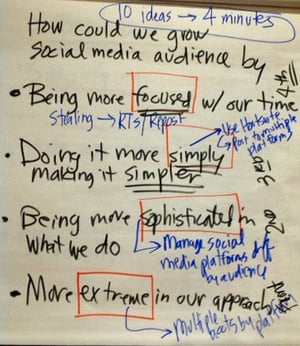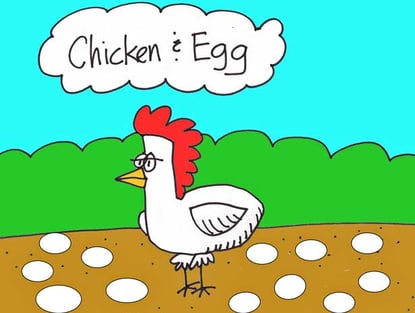Suppose you see a new opportunity in front of a live audience where there are high expectations.
Do you risk trying something you've never done before in front of the audience, or do you go safe and file it away to try in a more familiar venue later?
That was a question at several points during the Transportation Sales & Marketing Association Bootcamp I did this week on "Shoestring Marketing - Doing New with Less." We covered a wide variety of Brainzooming strategic thinking exercises during the workshop and had the extra time to consider trying some new things.
A Different Test for a Strategic Thinking Exercise
To demonstrate the value of using targeted creative questions to point groups in different creative directions, each row of attendees received a different modifier to explore ideas for how to do more with social media on a limited budget. Two rows received modifiers to "narrow" ideas (simpler, more focused). One of the rows had a "broadening" word (sophisticated), and the other received a "modifying" word (extreme).
Each row had four minutes to generate ten ideas using the assigned modifier. I then asked each row to share the favorite ideas to emerge.
Sure enough, each row had a different favorite answer. More importantly, the only rows that generated the same answer as another row's favorite were the two rows that were both working with narrowing modifiers.
While I'd never used this test previously to demonstrate why it's valuable to provide structure to generate ideas (vs. starting with the proverbial "clean sheet of paper"), this experiment was a great validation of the point for attendees.
Issuing a New Challenge to Marketers
In one of the strategic exercises, I asked the marketers to list their companies' five most demanding customers and prospects as typified by those who:
- Push for new products and services
- Have higher expectations
- Are more complex
- Are eager to pilot new offerings
I introduced this completely new in-workshop strategic thinking exercise as a pre-cursor to sharing a research approach to stay in front of market trends.
As I watched the audience work on their answers, however, it was clear some participants were struggling to come up with five customer names.
In the spur of the moment, I told the group I wouldn't ask them to report who could come up with five names and who couldn't. But I cautioned those who couldn't come up with five names that this signaled they, as marketers, were too far away from sales. A strategic marketer should be, if nothing else, in conversations with sales management and sales people that regularly surface the names of both positive and challenging accounts.
Taking the Risks and Getting the Returns
So, in answer to the opening question, I took the risk on both of these brand new twists on strategic thinking exercises. Both paid off successfully.
The learning for the workshop attendees, and hopefully for you, is two-fold:
- Avoid starting to generate ideas with a clean sheet of paper, absent structure and direction to help your creative thinkers
- If you're in marketing, stay close to sales and learn, learn, learn about customers
And the learning for us is that both of these drop-in trial balloons have a high probability of showing up in future strategic thinking workshops. - Mike Brown






